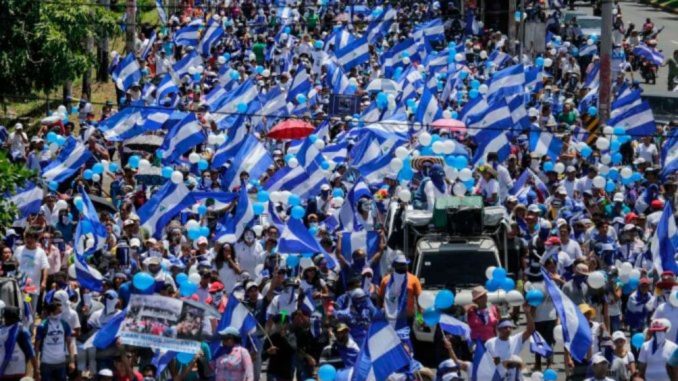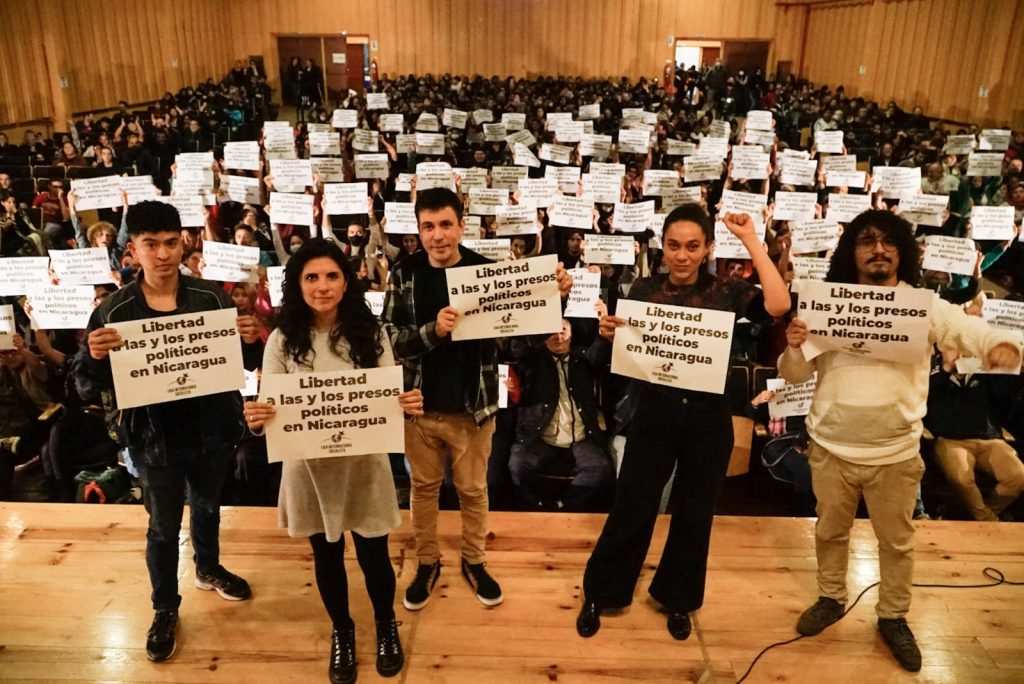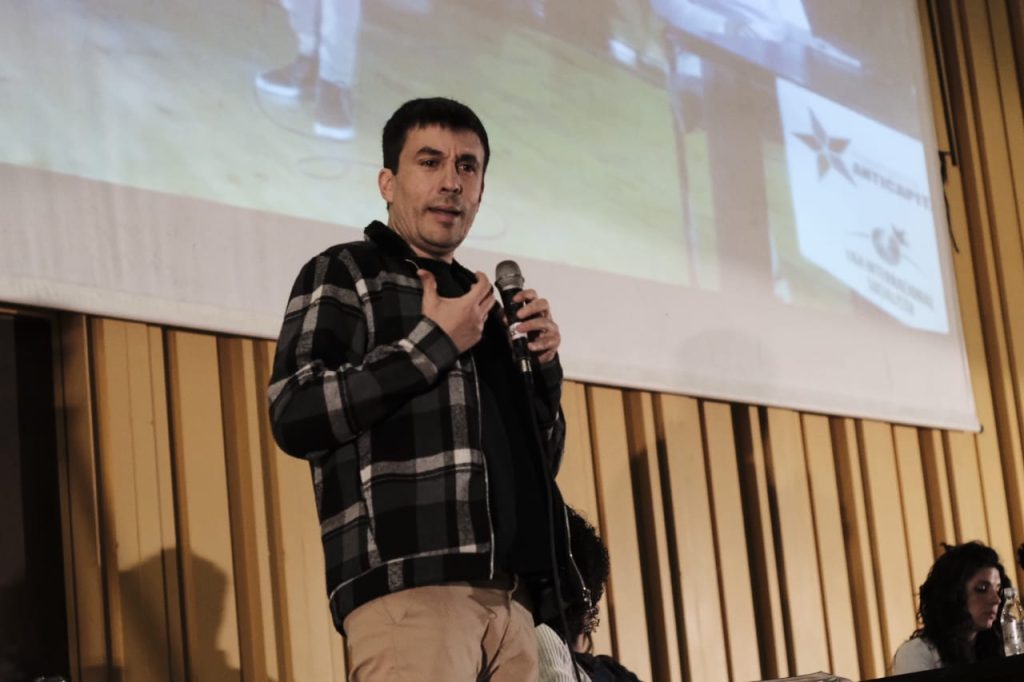
The action carried out by the ISL and the International Commission of the life and freedom of the political prisoners in Nicaragua left conclusions and open debates. The Ortega-Murillo regime blocked our entrance to the country, but it will not prevent us from fulfilling several objectives. The first one is communicating to the world the complete reality of what is happening in that nation. The recollection of testimonies for the drafting of a Final Report; the interaction with protagonists of this political process since 2018, and way before that too, allows us to start putting together the pieces to clarify a real puzzle. The comprehensive X-rays of a reality seen from a leftist critical stance that does not cover, silence or justify. It explains, provides information and is present.
by Mariano Rosa, coordinator of the International Commission representing the ISL
The role of the International Commission became a very relevant political event in the Nicaraguan exile and especially in the resistance organized from Costa Rica, a country that borders Nicaragua. The consequences of this intervention, coordinated by the ISL, were very powerful:
*In the face of an international geopolitics gravitating towards Eastern Europe with the war in Ukraine, it was very meritorious to put the situation in Nicaragua on the agenda.
*The repressive action of Ortega-Murillo that succeeded in turning the movement against him also provoked demoralization, skepticism and confusion. Logically, such a context explains the divisions and tensions between groups and collectives. The Commission managed to rearticulate a very broad unity of the whole rich arc of resistance in exile. This is another important point in favor.
*Without exaggerating, the determination to reach the border and present a direct, physical challenge to the dictatorship surprised the ruling duo. That forced a disproportionate military response at the border, its unprecedented closure and days later, precipitated the removal of the ambassador in Costa Rica.
*Finally, doing everything from a leftist position cancelled the possibility of invoking the argument that we were acting as a transmission belt for the White House. Of course, all this orientation, moralized, sowed expectations in organizations and family members, and set tasks. In the immediate future, the preparation of a Report that will be ready in the next few weeks and will surely be a new event. But, we want to reinforce a crucial aspect of all this internationalist movement: to show the other Nicaragua, the one that neither the right wing nor the concealing progressivism want to exhibit.
A country in prison
We want to graph what is happening in Nicaragua, in terms of violation of all democratic freedoms, with documented examples of testimonies we collected and evidence we collected.
*From April 2018 until now, there are almost 400 murders for protesting. That figure, surpasses the crimes of Somoza in his first decade of dictatorship.
*The “Operation Cleanup”: it was executed during July 2018 to sweep tranques, “hunt” opponents in their homes and pulverize all vestige of self-organization and protest, it left dozens dead. It was led by paramilitary forces.
*The Carazo Massacre and the “Piel” case: Carazo, south of Managua, was the epicenter of one of the toughest blockades in the country. There was armed self-defense and the FSLN paramilitaries were repelled. The viciousness with which this picket was shot with war weapons is remembered as the “Carazo Massacre”: 28 killed. A month ago, now in 2022, one of its leaders, Rodolgo Rojas, alias “Piel”, exiled in Costa Roca as a construction worker, was kidnapped and his body was found on the border with Honduras. He had been shot in the head and chest at close range. In addition, his nails and teeth had been pulled out. Very serious.
*The political prisoners of Chipote: this prison is the political prison par excellence. There, social and political leaders are subjected to systematic torture. In addition to beatings, isolation and punishment cells, lack of medical attention, they have been given contaminated food several times. It has been almost 2 months since the relatives have been able to visit their loved ones.
*The Jaime Navarrete case: sentenced to 22 years in prison for the crime of homicide, which was not proven. This July 24 he spent his 4th birthday in prison. He was granted amnesty in 2019 and recaptured, the second time falsely accused of possession of weapons and drugs. His family denounces that he is being held incommunicated, tortured and isolated.
*The Parajón case: Jimmy Parajón, just over 30 years old, supported the youth protests of April 2018. He was killed by a shot in the chest with a war weapon. Yader, his brother, from then on became an active participant in the mobilizations against the regime. He was imprisoned, granted amnesty and recaptured. In February of this year, a farce trial sentenced him for “conspiracy” to 10 years in prison.
*The “water carriers”: a group of 16 young people in Masaya showed solidarity by bringing water to a group of mothers and relatives of prisoners, who were taking refuge in the church of San Miguel on hunger strike. They defied the police siege and reached the billeted people. In November 2018 they were captured and imprisoned. They suffered months of jail and torture.
*The press and forced exile: the regime closed 38 media outlets and there are according to estimates almost 200 journalists in exile. There was persecution, imprisonment and confiscation of buildings.
*The elimination of academic records: the regime expelled activists from public universities and eliminated their academic records. Thus, students with 4 or 5 years of studies had their careers cut short.
*900 organizations banned: from philanthropic NGOs to feminist collectives were banned and their assets and headquarters confiscated.
*Undeclared state of police and siege: in Nicaragua there is no right to protest, there is no right of assembly, nor of any kind. The institutionalized accusation, in addition, works in every neighborhood and public dependency. It is a regime that has turned the country into a prison. If this is not a dictatorship, what is it called? To call a spade a spade. Nothing to justify, everything to fight.

The economic matrix, imperialism and class privileges: dictators and capitalists.
In the case of Nicaragua there is an objective collaboration between the right and progressivism (including the decadent Communist Parties) in the task of covering up, biasing or silencing a fundamental aspect of the whole project headed by Ortega-Murillo: the social nature of the interests they represent, the economic matrix they defend. Before qualifying it, let us describe it.
*The country we are talking about has a territorial surface of 11.9 million hectares, there are 229 metallic mega-mining concessions as of 2021, covering 2.8 million hectares and representing 23% of the country’s territorial surface. Ortega-Murillo, granted 114 of those concessions, being by far the government that handed over the most territory to imperialist capital.
*Albanisa is a company that was established as a fraudulent mechanism to privatize, in favor of Ortega, the Venezuelan oil subsidies. The funds were channeled as an operation between private companies, despite the fact that they originated in an international agreement. According to official data from the Central Bank, the total amount of credits channeled by Albanisa, as of June 2018, is close to 4 billion dollars. It came to average 500 million dollars per year. A liquid capital that Ortega managed discretionally, as private capital.
*From that company as a business cover for the ruling couple, the latter “diversified” its investments: Albageneración, the main electric power generating company. Albadepósitos, dedicated to the importation, storage and distribution of oil and petroleum products. Albaforestal, whose business is timber. Albaequipos (Econsa), a service and construction company. DNP, a fuel distribution company. Even a surveillance company appears in the extensive list. All under direct control of the dictatorship.
But, to make use of his position in the State for his personal fortune was not all: it was also necessary to legalize the cover-up. Thus, with the support of the Supreme Court of Justice, the Public Registry of Property became secret. That is to say: no one can know who owns what property before 2018.
*The jewel of the personal fortune of the Ortega-Murillo family is Bancorp. After 2018, this private bank received a trust with assets transferred from other companies, service providers to the State of Nicaragua. Bancorp’s assets amount to US$ 2.5 billion. That figure is an estimated reference point of the personal fortune of Ortega-Murillo, i.e.: they are dictators, to eradicate any real opposition. But essentially, they are repressors to preserve the impunity that assures them to continue profiting and enriching themselves and their entourage. Neither anti-imperialist, nor leftist: they are capitalists, emerging bourgeoisie of a plundered country with links to big international capital.
Is this the progressive and leftist matrix besieged by imperialism that should not be criticized in order not to be functional to the Yankee embassy? Ridiculous. And data, categorical. Data kills narrative.

Our April theses (2018 version) and the FSLN counterrevolution.
In April 2018 a real semi-insurrection took place. A massive rebellion, which paralyzed the political power, which cornered the FSLN government and which withdrew the entire enormous military-police-parapolice apparatus.
*There were about 150 pickets all over the country.
*The main universities were occupied. *Barricades and armed self-defense for weeks. *Convergence in the action of old cadres of critical Sandinismo, the independent peasant movement and a young generation of students – and of the popular neighborhoods – who raised the program of the rebellion to the demand that Ortega-Murillo leave.
The dictatorship panicked. Never had it been challenged on such a large scale and never had it been so socially isolated. With a keen sense of smell it understood that an adversary was potentially emerging in the streets that seriously threatened business and impunity. Hence, from this accurate characterization, the magnitude that explains the institutionalization of repression on a general scale: the FSLN is planning and executing a full-scale counterrevolution. Hence its criminality against humanity. Hence its implacable orientation. Hence, its genocidal nature. It is all or nothing. Fortunes and jail are at stake. Everything to lose. Hence the ruthlessness and brutality. This explains it. That is why, in the context of a massive rebellion, the role of the Church leadership and the big businesses represented by COSEP was nefarious and instrumental to Ortega-Murillo: the dialogue divided the waters in the rebel movement and isolated the most combative wing, which without national centralization was being defeated trench by trench. An important lesson in this part of the assessment: without national centralization that concentrates the energy of such a movement, there is no chance of defeating a counterrevolutionary regime trained for repression. Learn, so as not to repeat.

Three ongoing debates and the contribution of the ISL
Every process of rebellion and brutal response, such as that of the dictatorship in Nicaragua, opens controversies, debates, uncertainties and nuances among organizations and their activism. It is almost a law. In this context, we would like to briefly and schematically give our vision.
Debate 1: how to end the dictatorship?
There is a history of enormous political violence, deaths and frustration among the Nicaraguan people. First Sandino, in the 1930s. Then the struggle against Somoza, 40 years of dictatorship. The 1979 revolution and the civil war against the Contras. Now, since 2018, again, dictatorship, exile, dead. It is understandable the penetration of the false exit of the “dialogues” that end up lowering the guard to the resistance and the institutional exits, controlled from above. There is an experience with the intervention of big businesses and the clerical leadership. All this road led to a dead end, and Ortega-Murillo capitalized on it. The only moment in which the dictatorship was paralyzed, impotent and on the edge of the cliff was with the massive popular mobilization. Evidently, we refer to the evidence: this is the most powerful resource of any people in struggle, including the right to armed self-defense. Always with democratic self-organization and coordinated centralization. At the international level, to encircle the ruling couple. Isolating the regime and giving oxygen to the internal resistance. That is the way, we are convinced.
Debate 2: are there two stages?
This is a recurring theme, and another key point. The day after the dictatorship is not separated from the current struggle to throw it out, in a revolutionary manner with massive mobilization. In reality, the program is a single program with a combination of tasks, starting with the life and freedom of the political prisoners, to throw out the dictatorship and from there, a democratic, free and sovereign reorganization through a constituent process towards another Nicaragua and a government of those who never governed: the workers, the poor people, without capitalists, without repressors. Therefore, the need for a global political strategy, combining unity of action to oust Ortega-Murillo, and at the same time, strategic delimitation of all corporate and gringo-friendly power camps, from now on, is fundamental. Without that, the youth, the exile, the peasantry will return to put the dead and the sacrifices, and those who in the end ride on that effort, end up kidnapping the political power to retake their minority business. This cannot be allowed.
Debate 3: does the experience of the FSLN (and allies) challenge any leftist project?
The bourgeois, capitalist, dictatorial Sandinism, executioner of its people, dragged the flag of the left and anti-imperialism to the ground. Its regional allies, such as the Cuban CP or senile Chavism, add their share of confusion. But those projects have nothing to do with socialism or the emancipatory conceptions that we defend, for example, from the ISL. We are left with an internationalist vision, and in that, without commitment to any capitalist power, we promote the broadest political democracy to decide everything: in a country governed by those from below, in the organization itself to deliberate, build politics, control the leaders and decide everything. Without that, in a country or in the organization itself, there is bureaucracy, privileges and conservative and reactionary reversal of any positive process of change. This is the experience of Stalinism in the former USSR. It is the experience of Chavismo that did not advance. Obviously, it is the experience of the FSLN at the beginning, cohabiting with business sectors. And of course, Cuba and the aberrant one-party regime. There is another left, and it is growing.
The contribution of the International Socialist League
Our international organization, the International Socialist League, the leader of the Commission, still has much to contribute to the Nicaraguan cause, which is Latin American and world-wide. First, we intend to be the best militants of the broadest unity of action, for the emerging priorities: life, freedom for the hostages of the dictatorship and the departure of Ortega-Murillo and their regime. In that, we have not the slightest doubt. But, at the same time, it is essential to build a third political field that fights the dictatorship in a consistent way, but that is quite independent of any gringo interference. No imperialism should intervene in anything after the ruling clan is ousted. Our direct experience with the best of the exile in resistance, made us realize that we are facing a possibility that will depend on what we do: to synthesize in a powerful confluence, cadres and militants who left Sandinismo in a self-critical way; the young activism “generation of April 2018” and a force like the ISL, whose Nicaraguan section, Alternativa Anticapitalista, in the process of construction, proposes itself as an articulator of all these strands. In this convergent crossroads is the possibility from now on, to build a political project that expresses the best aspirations of this extraordinary rebellious people of Nicaragua. On our part, we are proud to be able to occupy a place of struggle in this exciting Central American trench.








